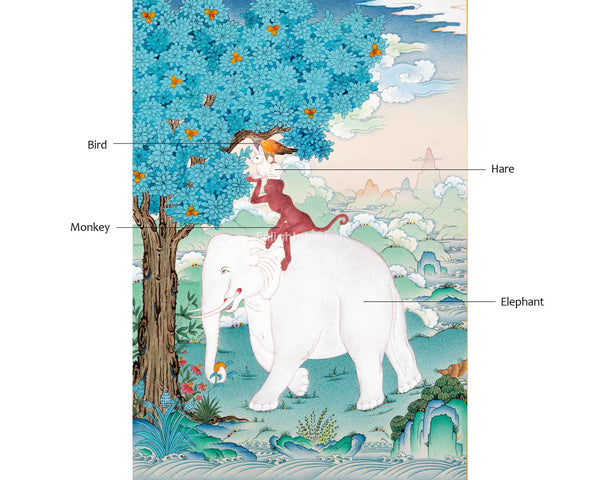The Four Harmonious Friends Story: Symbol of Unity and Cooperation
In ancient folklore and symbolism, the story of the Four Harmonious Friends — a bird, a hare, a monkey, and an elephant — holds a special place. This narrative, involving a bird, a hare, a monkey, and an elephant, has been passed down through generations, transcending cultural and geographical boundaries. Its lessons are as relevant today as they were centuries ago, offering insights into how society can achieve harmony.
Key Takeaways
- The Four Harmonious Friends is an allegory emphasizing unity, cooperation, and the respect of natural hierarchy.
- Originating from Buddhist teachings, the story is vital to cultural heritage across various Asian countries.
- Each character embodies unique virtues and imparts distinct moral lessons.
- The tale remains relevant today, teaching valuable teamwork, leadership, and ecological balance lessons.
Beyond a mere fable, the Four Harmonious Friends is a profound allegory encapsulating the core principles of unity and cooperation amid diversity. This timeless narrative transcends generations and cultural boundaries, featuring a bird, hare, monkey, and elephant. Its enduring lessons remain pertinent, providing insights into achieving harmony in contemporary society.
Historical and Cultural Background
Buddhist Origins
Believed to stem from the rich tapestry of Buddhist teachings, the narrative finds its roots in the Jataka tales, recounting the Buddha's past incarnations, often in animal form. Serving as a conduit for moral and ethical lessons, the Four Harmonious Friends stands as a notable example.
Influence Across Asia
This narrative has resonated across diverse Asian cultures, each interpreting it through the lens of their values and traditions. Nations like Bhutan, Tibet, and India hold the story in high regard, and its cultural and religious significance is evident. Aligned with these societies' spiritual and communal values, the themes of cooperation and respect for the natural world remain integral to the tale.
The Symbolic Representation of Each Animal 
Four Harmonious Friend Wall Hanging
| Animal | Representation | Quality |
| Bird | Foresight, Wisdom | Vision, Leadership |
| Rabbit | Fertility, Growth | Nurturing, Caring |
| Monkey | Agility, Resourcefulness | Intelligence, Adaptability |
| Elephant | Strength, Steadfastness | Humility |
The Elephant: Symbol of Strength and Wisdom
- Strength and Stability: In Buddhist iconography, the elephant, the most significant and most robust among the quartet, symbolizes physical strength, stability, and a grounded nature. The tale illustrates a powerful lesson in humility and respect as the elephant acknowledges the bird's seniority despite differences in size.
- Majestic Wisdom: Elephants are revered for their wisdom and memory across various cultures, including Buddhism. Within the narrative, the elephant imparts the knowledge that true insight lies in recognizing and respecting the experiences and contributions of others, regardless of their perceived significance.
The Monkey: Embodiment of Agility and Cleverness
- Adaptability and Resourcefulness: Monkeys, renowned for their agility and cleverness, symbolize the capacity to navigate diverse situations effortlessly. Within the narrative, the monkey's cooperative spirit and problem-solving aptitude underscore the significance of intelligence and adaptability in conflict resolution, fostering harmony.
- Joyful Playfulness: Linked with playfulness and joy, the monkey serves as a reminder to approach life enthusiastically. This attitude is instrumental in surmounting challenges, collaborating positively, and fostering a constructive environment.
The Rabbit: Representation of Fertility and Care
- Nurturing and Empathy: The rabbit within the narrative symbolizes care, nurturing, and growth, emphasizing the significance of empathy and compassion in human interactions. The rabbit's role underscores the essential nature of caring and nurturing for fostering a harmonious community.
- Gentleness and Vulnerability: Rabbits, often perceived as gentle and vulnerable, convey the message in the story that vulnerability is not a weakness but a strength. Their representation highlights how embracing vulnerability can cultivate deeper connections and understanding within diverse groups.
The Bird: Symbol of Vision and Foresight
- Initiator and Visionary: The bird responsible for planting the tree symbolizes foresight and vision, embodying the concept that significant achievements often stem from modest origins. Through its role in the narrative, the bird imparts the importance of long-term vision and thoughtful planning.
- Wisdom and Perspective: Birds, known for their ability to soar high, are linked to a higher perspective and wisdom. In the Four Harmonious Friends, the bird's viewpoint is pivotal in conflict resolution. This underscores the lesson that, at times, gaining solutions and fostering mutual understanding requires stepping back and examining the broader picture.
Symbolic Interpretations of the Four Harmonious Friend
Unity Amidst Diversity
The narrative illustrates the harmonious collaboration of beings with varied sizes, strengths, and abilities. This theme resonates in today's globalized and multicultural world, emphasizing the essential nature of cooperation among diverse groups.
Hierarchical Harmony
The tale introduces the concept of a natural hierarchy, where leadership is rooted in wisdom and experience rather than physical prowess. This facet underscores the importance of respecting elders and individuals with more experience.
Layers of Meaning in Mutual Respect and Unity
The Four Harmonious Friends eloquently convey the potency of mutual respect and unity, asserting that respect should transcend size or power, focusing instead on understanding and acknowledging each individual's unique contributions and history. The story underscores the significance of unity, particularly in diverse groups, illustrating how it fosters peaceful coexistence and mutual prosperity.
The Significance of Cooperation and Interdependence
Embedded in this narrative is a fundamental Buddhist teaching, emphasizing the principle of interdependence. Despite their differences, each animal in the tale plays a vital role in the harmonious existence of their collective.
This aligns with the Buddhist perspective that all forms of life are interconnected, and their cooperative efforts are crucial for the balance and well-being of the ecosystem. The story encourages us to recognize our interdependence and collaborate for the greater good.
Modern-Day Relevance
The Four Harmonious Friends imparts timeless lessons applicable in contemporary contexts, from corporate teamwork to environmental conservation. Its focus on mutual respect, understanding, and collaboration is relevant in addressing pressing global issues like climate change and social inequality.
Artistic Representations
The narrative has found expression in various artistic forms, from ancient temple murals to modern digital artwork. These depictions not only capture the essence of the story but also serve as enduring reminders of the profound impact of its message.
In summary, with its rich symbolism and profound moral teachings, the Four Harmonious Friends remains a timeless narrative. It imparts lessons on unity, cooperation, and respect for the natural order, providing a guiding framework for harmonious living that is as pertinent today as it was in ancient times.










